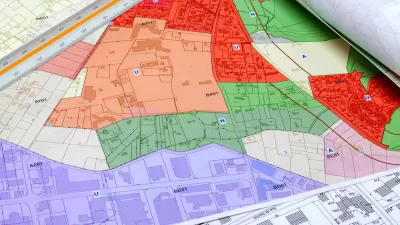Increasing mileage standards will do little to measurably reduce greenhouse gas emissions. In order to seriously tackle climate change we need to ditch the cars, and the development patterns they encourage, and move to walkable places.
In an exceprt from his new book, Walkable City: How Downtown Can Save America, One Step at a Time, Jeff Speck addresses the connection between density, walkability, and greenhouse gas emissions.
"It turns out that trading all of your incandescent lightbulbs for energy
savers conserves as much carbon per year as living in a walkable
neighborhood does each week," observes Speck. "Why, then, is the vast majority of our
national conversation on sustainability about the former and not the
latter?"
"Places should be judged not by how much carbon they emit, but by how
much carbon they cause us to emit. There are only so many people in the
United States at any given time, and they can be encouraged to live
where they have the smallest environmental footprint. That place turns
out to be the city - the denser the better."
"Quality of life - which includes both health and wealth - may not be a
function of our ecological footprint, but the two are deeply
interrelated. To wit, if we pollute so much because we are throwing away
our time, money, and lives on the highway, then both problems would
seem to share a single solution, and that solution is to make our cities
more walkable. Doing so is not easy, but it can be done, it has been
done, and indeed it is being done in more than a few places at this very
moment."
FULL STORY: Stop climate change: Move to the city, start walking

Planetizen Federal Action Tracker
A weekly monitor of how Trump’s orders and actions are impacting planners and planning in America.

Restaurant Patios Were a Pandemic Win — Why Were They so Hard to Keep?
Social distancing requirements and changes in travel patterns prompted cities to pilot new uses for street and sidewalk space. Then it got complicated.

Map: Where Senate Republicans Want to Sell Your Public Lands
For public land advocates, the Senate Republicans’ proposal to sell millions of acres of public land in the West is “the biggest fight of their careers.”

Maui's Vacation Rental Debate Turns Ugly
Verbal attacks, misinformation campaigns and fistfights plague a high-stakes debate to convert thousands of vacation rentals into long-term housing.

San Francisco Suspends Traffic Calming Amidst Record Deaths
Citing “a challenging fiscal landscape,” the city will cease the program on the heels of 42 traffic deaths, including 24 pedestrians.

California Homeless Arrests, Citations Spike After Ruling
An investigation reveals that anti-homeless actions increased up to 500% after Grants Pass v. Johnson — even in cities claiming no policy change.
Urban Design for Planners 1: Software Tools
This six-course series explores essential urban design concepts using open source software and equips planners with the tools they need to participate fully in the urban design process.
Planning for Universal Design
Learn the tools for implementing Universal Design in planning regulations.
Heyer Gruel & Associates PA
JM Goldson LLC
Custer County Colorado
City of Camden Redevelopment Agency
City of Astoria
Transportation Research & Education Center (TREC) at Portland State University
Camden Redevelopment Agency
City of Claremont
Municipality of Princeton (NJ)





























